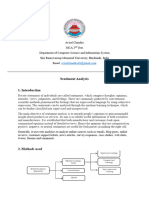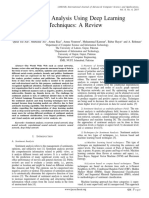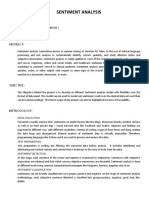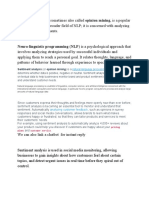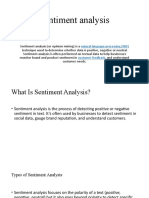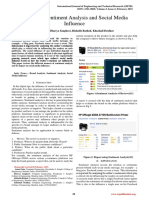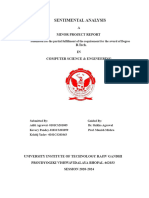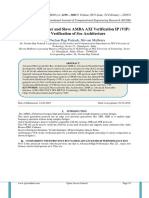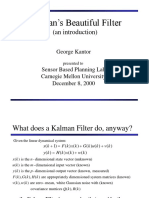SENTİMENT ANALYSİS and COMPUTER SCİENCE
Hello and welcome! Today, we'll explore sentiment analysis, a technology that helps us understand
emotional tones in written text, and the role of computer science in this field. We'll look at how sentiment
analysis works, its applications, and its future potential.
1. Introduction: What is Sentiment Analysis?
• Sentiment Analysis is the process of using natural language processing (NLP) and machine learning
techniques to determine the emotional tone behind a series of words. The goal is to understand whether the
sentiment expressed is positive, negative, or neutral.
• Why it matters: Understanding emotions in text can help in improving customer service, monitoring social
media, analyzing public opinion, and even guiding business strategies.
Example Applications:
• Social media monitoring
• Customer feedback analysis
• Product or movie reviews
2. How Sentiment Analysis Works
There are three primary methods used to perform sentiment analysis
1. Rule-Based Approaches:
○ Uses predefined lists of words (lexicons) and rules to determine sentiment.
○ Example: Words like “happy” and “great” are labeled as positive, while “sad” and “angry” are labeled as
negative.
2. Machine Learning Methods:
○ Supervised learning techniques use labeled datasets to train models to classify sentiment.
○ Example algorithms: Naive Bayes, Support Vector Machines (SVM), and Decision Trees.
3. Deep Learning Approaches:
○ Uses large datasets and neural networks for more complex sentiment classification.
� ○ Example models: Long Short-Term Memory (LSTM), BERT (Bidirectional Encoder Representations from
Transformers), and GPT (Generative Pretrained Transformer).
○ These methods can capture context and understand subtleties better than rule-based or simpler
machine learning methods.
3. Applications of Sentiment Analysis
Sentiment analysis is widely used in various domains. Here are some key applications:
1. Social Media Monitoring:
○ Track public sentiment on platforms like Twitter, Facebook, or Instagram to understand how people feel
about a brand, political event, or news story.
2. Customer Feedback and Reviews:
○ Analyze product or service reviews to gauge customer satisfaction, identify issues, and improve
offerings.
3. Market Research:
○ Businesses analyze consumer sentiment to understand market trends and improve targeted marketing
strategies.
4. Healthcare:
○ Analyze patient feedback or forums to understand emotional well-being and improve services.
5. Financial Markets:
○ Sentiment analysis is increasingly used to analyze public opinion or news sentiment and predict stock
market trends.
4. Computer Science and Sentiment Analysis
Computer Science plays a crucial role in the development and application of sentiment analysis technologies.
The discipline contributes through several areas:
Key Technologies:
1.Natural Language Processing (NLP):
○ NLP allows machines to understand, interpret, and respond to human language. It's the foundation for
analyzing sentiment in text.
2. Machine Learning:
� ○ Machine learning models learn patterns from large datasets and improve as they process more data,
making them critical for sentiment classification tasks.
3. Deep Learning:
○ Advanced neural networks enable models to understand more complex patterns, including context,
sarcasm, and emotional subtleties in text.
4. Big Data Processing:
○ Sentiment analysis often deals with large volumes of data, requiring the use of big data frameworks
such as Hadoop, Spark, or cloud computing platforms.
Role of Computer Science:
• Data Preprocessing: Cleaning and transforming raw data into a usable form.
• Algorithm Development: Creating the models that can accurately predict sentiment.
• Scalability: Ensuring that sentiment analysis can be applied to massive datasets, such as social media
streams.
• Real-Time Processing: Implementing systems that can analyze and report sentiment in real-time (e.g.,
during live events).
5. Future Trends and Opportunities
The future of sentiment analysis looks promising, with several emerging trends:
1. Multimodal Sentiment Analysis:
○ Combining text, audio, and visual data to understand sentiment more comprehensively. For example,
analyzing a person’s tone of voice in combination with the words they speak.
2. Emotion AI (Affective Computing):
○ AI systems that can recognize and respond to human emotions. This will allow more human-like
interactions in customer service, healthcare, and entertainment.
3.Real-Time Sentiment Analysis:
○ Sentiment analysis models will become even more capable of processing large-scale data in real-time,
providing instant feedback for business decisions or social media monitoring.
4. Sentiment and Predictive Analytics:
○ Sentiment analysis could be integrated with predictive analytics to forecast trends, such as predicting
stock prices or political outcomes based on public sentiment.
6. Conclusion
� • Sentiment analysis is an essential tool for understanding human emotions in the digital age, providing
valuable insights for businesses, governments, and individuals.
• Computer Science provides the foundation for sentiment analysis, from natural language processing and
machine learning to big data and deep learning technologies.
• Despite the challenges, sentiment analysis continues to evolve, offering exciting opportunities for future
applications in a wide range of industries.











